Hedi Ben-younes
RUBi: Reducing Unimodal Biases in Visual Question Answering
Jun 24, 2019
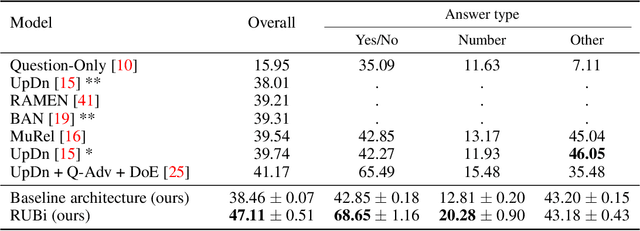
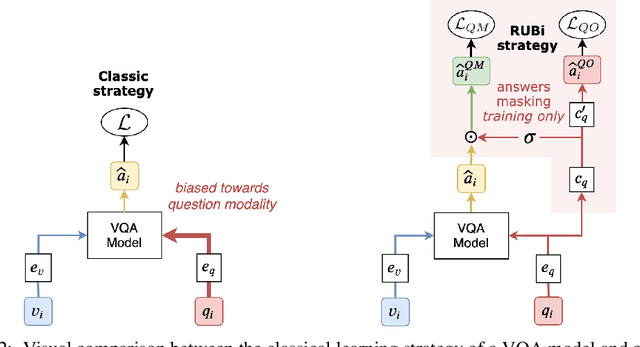
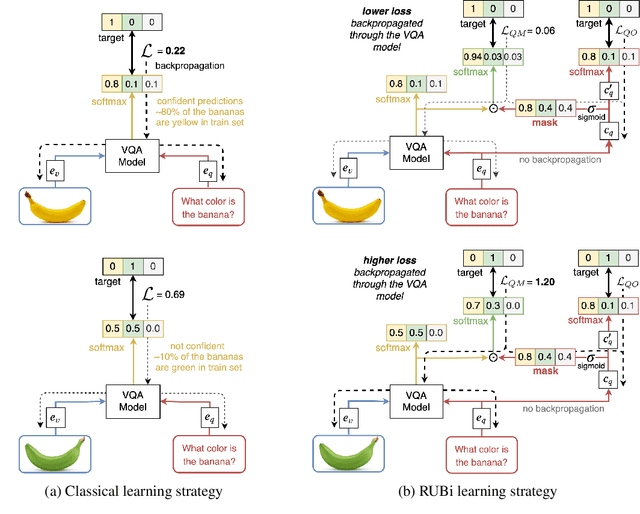
Abstract:Visual Question Answering (VQA) is the task of answering questions about an image. Some VQA models often exploit unimodal biases to provide the correct answer without using the image information. As a result, they suffer from a huge drop in performance when evaluated on data outside their training set distribution. This critical issue makes them unsuitable for real-world settings. We propose RUBi, a new learning strategy to reduce biases in any VQA model. It reduces the importance of the most biased examples, i.e. examples that can be correctly classified without looking at the image. It implicitly forces the VQA model to use the two input modalities instead of relying on statistical regularities between the question and the answer. We leverage a question-only model that captures the language biases by identifying when these unwanted regularities are used. It prevents the base VQA model from learning them by influencing its predictions. This leads to dynamically adjusting the loss in order to compensate for biases. We validate our contributions by surpassing the current state-of-the-art results on VQA-CP v2. This dataset is specifically designed to assess the robustness of VQA models when exposed to different question biases at test time than what was seen during training. Our code is available: github.com/cdancette/rubi.bootstrap.pytorch
MUREL: Multimodal Relational Reasoning for Visual Question Answering
Feb 25, 2019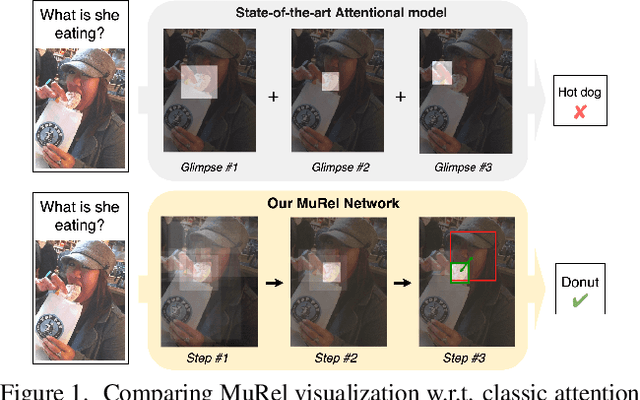
Abstract:Multimodal attentional networks are currently state-of-the-art models for Visual Question Answering (VQA) tasks involving real images. Although attention allows to focus on the visual content relevant to the question, this simple mechanism is arguably insufficient to model complex reasoning features required for VQA or other high-level tasks. In this paper, we propose MuRel, a multimodal relational network which is learned end-to-end to reason over real images. Our first contribution is the introduction of the MuRel cell, an atomic reasoning primitive representing interactions between question and image regions by a rich vectorial representation, and modeling region relations with pairwise combinations. Secondly, we incorporate the cell into a full MuRel network, which progressively refines visual and question interactions, and can be leveraged to define visualization schemes finer than mere attention maps. We validate the relevance of our approach with various ablation studies, and show its superiority to attention-based methods on three datasets: VQA 2.0, VQA-CP v2 and TDIUC. Our final MuRel network is competitive to or outperforms state-of-the-art results in this challenging context. Our code is available: https://github.com/Cadene/murel.bootstrap.pytorch
BLOCK: Bilinear Superdiagonal Fusion for Visual Question Answering and Visual Relationship Detection
Feb 12, 2019

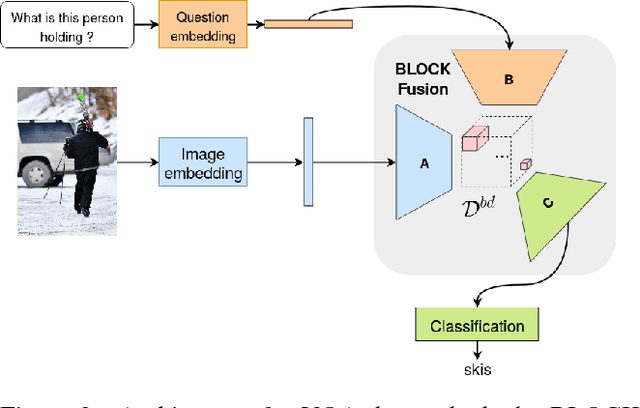

Abstract:Multimodal representation learning is gaining more and more interest within the deep learning community. While bilinear models provide an interesting framework to find subtle combination of modalities, their number of parameters grows quadratically with the input dimensions, making their practical implementation within classical deep learning pipelines challenging. In this paper, we introduce BLOCK, a new multimodal fusion based on the block-superdiagonal tensor decomposition. It leverages the notion of block-term ranks, which generalizes both concepts of rank and mode ranks for tensors, already used for multimodal fusion. It allows to define new ways for optimizing the tradeoff between the expressiveness and complexity of the fusion model, and is able to represent very fine interactions between modalities while maintaining powerful mono-modal representations. We demonstrate the practical interest of our fusion model by using BLOCK for two challenging tasks: Visual Question Answering (VQA) and Visual Relationship Detection (VRD), where we design end-to-end learnable architectures for representing relevant interactions between modalities. Through extensive experiments, we show that BLOCK compares favorably with respect to state-of-the-art multimodal fusion models for both VQA and VRD tasks. Our code is available at https://github.com/Cadene/block.bootstrap.pytorch.
MUTAN: Multimodal Tucker Fusion for Visual Question Answering
May 18, 2017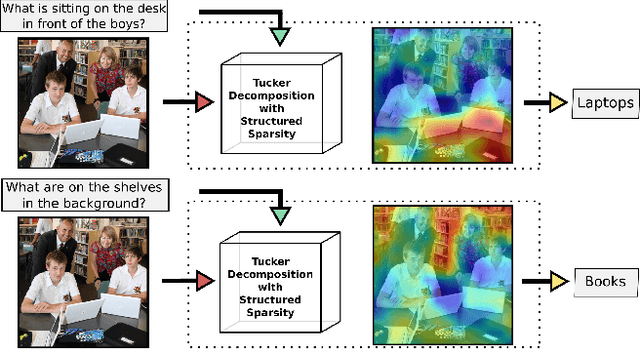
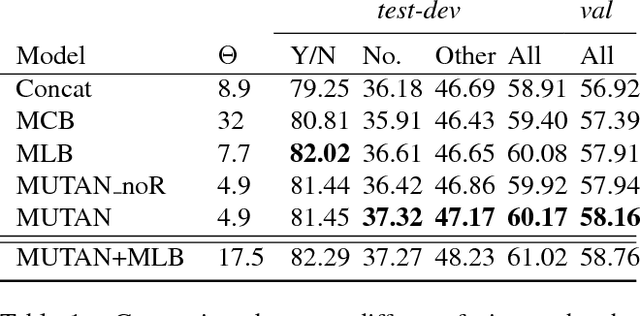

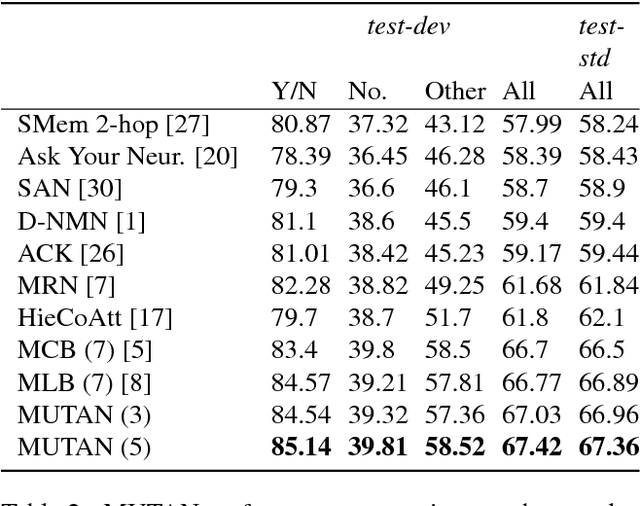
Abstract:Bilinear models provide an appealing framework for mixing and merging information in Visual Question Answering (VQA) tasks. They help to learn high level associations between question meaning and visual concepts in the image, but they suffer from huge dimensionality issues. We introduce MUTAN, a multimodal tensor-based Tucker decomposition to efficiently parametrize bilinear interactions between visual and textual representations. Additionally to the Tucker framework, we design a low-rank matrix-based decomposition to explicitly constrain the interaction rank. With MUTAN, we control the complexity of the merging scheme while keeping nice interpretable fusion relations. We show how our MUTAN model generalizes some of the latest VQA architectures, providing state-of-the-art results.
 Add to Chrome
Add to Chrome Add to Firefox
Add to Firefox Add to Edge
Add to Edge